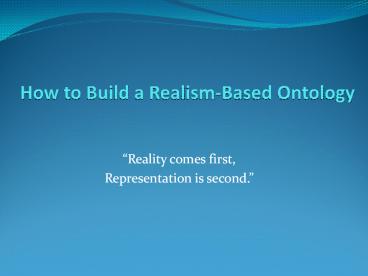How%20to%20Build%20a%20Realism-Based%20Ontology - PowerPoint PPT Presentation
Title:
How%20to%20Build%20a%20Realism-Based%20Ontology
Description:
Built on the basis that reality is given independent of the observer. Defines the most general categories needed ... Based on definitions by Merriam Webster: ... – PowerPoint PPT presentation
Number of Views:20
Avg rating:3.0/5.0
Title: How%20to%20Build%20a%20Realism-Based%20Ontology
1
How to Build a Realism-Based Ontology
- Reality comes first,
- Representation is second.
2
Realist Ontology
- The science of what exists in reality.
- What is being?
- What are the features common to all beings?
- Built on the basis that reality is given
independent of the observer. - Defines the most general categories needed to
describe reality and how these categories are
related. - Built out of representational units which are
intended to refer exclusively to universals. - Not to particulars. Repository What is specific.
3
Representational Units for an Optimal Ontology
- (1)Designate a single (11) POR (2)which is
relevant to the purpose of the ontology (3)and is
such that the author of the ontology intended to
use this unit to designate this POR (4)and no POR
exists that is relevant to the ontology that is
not referred to in the ontology. - A single portion of reality may include more than
one universal. - A POR may include a particular, however, a
representational unit in an optimal ontology may
not.
4
Three Levels of Reality
- Reality
- As it exists before observation.
- Cognitive representation (Observation)
- Representational artifacts (Sharing Observation)
- Building an image of reality based on cognitive
representation. Describes reality exactly as
reality is in terms of the observer.
5
Universals
- Entities which exist in the particulars amongst
which there is a relation of similarity not found
with other particulars. - Human being, arm, arm waving
6
Classes/Collections
- Collection of particulars that are instances of
the same universal. - Part_of relationship between subclasses and
classes. - If all members of subclass B are members of
class A, but not all members of class A are
members of subclass B, subclass B is a part of
class A. - Member of subclass B and member of class A.
Therefore - Class A (Superclass)
- Class B (Subclass)
- Terminology is used to refer to classes and their
qualities. The word should not be confused with
being the entity it denotes. - Terms denote classes and their qualities. The
terms should not be confused with being the
entities they are used to refer to. - Only universals have instances. Particulars on
not have instances.
7
Classes
- When a class identifier is substituted by a
synonym of the original identifier, all class
relationships should remain the same.
- Course
- Mathematics
- Algebra
- Trigonometry
- Calculus
- Course
- Arithmetic
- Algebra
- Trigonometry
- Calculus
8
Removing a class
A class should have instances of itself or it can
be removed. X Class
yz Instance http//ftp.info
rmatik.rwth-aachen.de/Publications/CEUR-WS/Vol-185
/semAnnot05-10.pdf
9
Instances/Particulars
- Particulars are instances of classes.
- Individual entities that preserve their identity
over time. - Me, my right arm, my right arm waving
- Nothing which is an instance can have an
instance.
10
Continuants
- Entities which continue to exist while undergoing
change. - When they exist, they exist in total.
- Require the specification of time.
- Must exist at a location.
11
Occurants/Processes
- A change that a continuant undergoes.
- At any point in time, they exist only in part.
- Do not require the specification of time.
- Belongs to a class until it is finished. When it
is finished, it no longer belongs to a class
because it no longer exists.
12
Ontology, Taxonomy, Classification
- Based on definitions by Merriam Webster
- Classification Systematic arrangement in groups
or categories according to established criteria. - Taxonomy Orderly classification of plants and
animals according to their presumed natural
relationships. - Ontology A branch of metaphysics concerned with
the nature and relations of being. - http//itc.scix.net/data/works/att/w78-2003-432.co
ntent.pdf
13
References
- http//www.cse.dmu.ac.uk/bstahl/publications/2005
_zelic_stahl.pdf - http//www.loa-cnr.it/Papers/KBKS95.pdf
- http//protege.stanford.edu/publications/ontology_
development/ontology101-noy-mcguinness.html - http//org.buffalo.edu/RTU/papers/Pres20050408.pps































